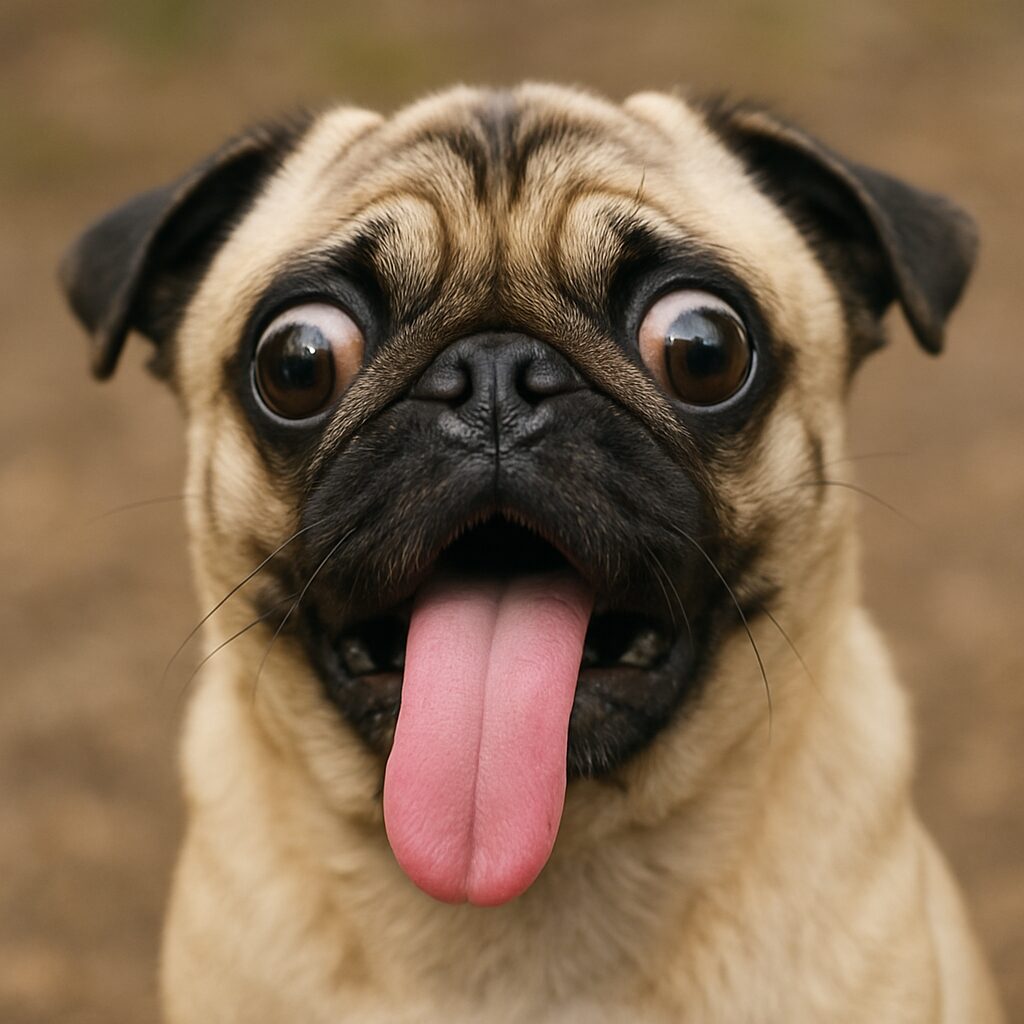When a photo of a pug in Japan went viral, tongue lolling like a pink ribbon, eyes bulging in comical shock, the internet didn’t quite know what to feel. Was it adorable? Was it unsettling? The verdict landed somewhere in between: “scary but cute.” Strangely enough, that phrase captures the essence of the pug’s enduring appeal. Behind the memes and social media giggles lies a fascinating blend of biology, psychology, and cultural history that explains why these wrinkled little dogs have enchanted Japan and the world for centuries.
The Science Behind That Silly Tongue
The photo that launched a thousand retweets wasn’t just funny timing. That dangling tongue is part of what makes pugs, well, pugs.
Veterinarians explain that brachycephalic breeds, dogs with shortened snouts like pugs, French bulldogs, and Shih Tzus, often develop what’s called Hanging Tongue Syndrome. Their tongues can appear oversized compared to their mouths, slipping out whether they mean to or not. Sometimes missing teeth or misaligned jaws make the tongue slide out even further.
And while it looks goofy, it serves a purpose. Dogs regulate heat by panting, letting air flow across the moist surface of their tongues to cool their blood. In flat-faced breeds, whose nasal passages are shorter and less efficient, the tongue works overtime. What the internet calls “scary-cute” is, in fact, biology doing its job.
Why We Love the “Scary-Cute” Look
Japan even has a word for it: kimo-kawaii meaning “gross-cute” or “scary-cute.” Think mascots with offbeat faces, plush toys with unsettling details, or characters that are just a little strange. It’s an aesthetic that thrives on contradictions.
Psychologists say this attraction comes from what’s known as the “baby schema” effect. Features like big round eyes, oversized heads, and soft bodies trigger our nurturing instincts. When something looks odd and infant-like, like a pug with bulging eyes and an askew tongue, our brains hesitate between discomfort and affection. That tension is exactly what makes us stare, laugh, and, ultimately, adore.
Pugs embody this paradox. Their wrinkles and googly eyes might appear exaggerated, but pair them with their clumsy sweetness and you get a creature that feels both bizarre and irresistible.
How Pugs Made Their Way to Japan
Though their viral fame feels modern, pugs carry a royal lineage stretching back over two millennia. In China’s Han dynasty, they lounged in the laps of emperors, prized for their compact size and deeply furrowed faces. By the 1500s, Dutch traders ferried them to Europe, where they became icons of nobility famously guarding the life of William the Silent, Prince of Orange, and appearing on coats of arms.
Japan didn’t meet the pug until the 19th and early 20th centuries, when Western breeds began arriving more widely. Their real boom came after World War II, as cities expanded and families looked for apartment-friendly companions. The pug’s small stature, loyalty, and clownish personality made it an instant fit for urban households.
Today, they rank among Japan’s top thirty breeds. You’ll see them in TV ads, manga panels, and Instagram reels. They’re often typecast as bumbling sidekicks who make people laugh just by existing.
Why Pugs Shine in Japanese Pop Culture
Japan has long celebrated animals as cultural touchstones: the steadfast Akita Hachikō immortalized in Shibuya Station, the fox spirits of folklore, and, more recently, the meme-famous Shiba Inu. Pugs slot naturally into this tradition.
Their faces exaggerate everything kawaii culture holds dear; roundness, imperfection, and a kind of clumsy uniqueness. Add in the idea of gap-moe, the charm that comes from contrast, and you have the perfect mascot. A pug’s fierce bulging eyes paired with its dopey sweetness create a delightful contradiction that Japanese audiences can’t get enough of.
What a Viral Pug Photo Really Says About Us
The tongue-wagging pug that took over Twitter isn’t just a fleeting meme. It reveals something deeper about our relationship with dogs. We don’t love them because they’re perfect; we love them because they’re odd, unpredictable, and full of quirks that remind us not to take life too seriously.
In Japan, where life often runs on precision and structure, dogs like pugs serve as a gentle rebellion. They wrinkle their brows at nothing, tumble into furniture, and grin with tongues askew. They delight us not because they’re elegant, but because they’re gloriously imperfect.
Embracing the Charm of the Unusual
The viral fame of one pug may fade, but the breed’s charm is timeless. From ancient Chinese palaces to crowded Tokyo apartments, pugs have stayed by our side, their oddball looks making them unforgettable. Call it scary, call it cute, or settle somewhere in between, but one thing is certain: a pug’s bug-eyed stare and silly pink tongue remind us that beauty often hides in the most unexpected places.

